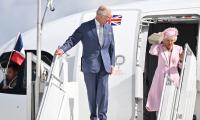In 2022-23, Pakistan’s gross external financing requirement stands at $28 billion. In the past seven months, our trade gap widened to an unprecedented $28.8 billion. The SBP has lost $1.5 billion of its reserves in the past five months. In 2018, our external debt stood at $95 billion which has since shot up to $130 billion – a 37 percent increase in just 41 months.
In 2018, our government paid out 10.5 percent of its revenue as external debt payments. Red alert: In 2022, an unsustainable 38.9 percent of government revenue has to be paid out as external debt payments. Currently, around 85 percent of our external debt is owed to US-dominated multilaterals, the Paris Club, the Bretton Woods institutions and commercial banks. Additionally, we owe China roughly $18 billion. Between now and June, $1.8 billion is due for repayment to multilateral institutions, $5.3 billion to commercial banks and the IMF plus $1.3 billion to bilaterals. That’s a massive $8.4 billion due for repayment between now and June. Alarmingly, the “repayment of foreign loans has gone up by 399 percent in the last four years.”
Pakistan’s external debt is a ticking time bomb – and a national security threat. Michael Mullen, a US Navy admiral, once said: “The strength and the support and the resources that our military uses are directly related to the health of our economy over time.”
We borrow dollars because we import a lot more than we export, and because we have failed to attract foreign direct investment. We import some $25 billion worth of petroleum products, coal and LNG; $25 billion worth of raw materials; $13 billion worth of machinery and $10 billion worth of food items.
To be certain, cutting down the import bill in any meaningful way is next to impossible. There are only two ways out. One, increasing domestic production of oil and gas. Two, enhancing exports.
According to the US Energy Information Administration (EIA), “Pakistan may have over 9 billion barrels of petroleum oil…” At the current rate of consumption, that would last us a good 50 years. According to the EIA, “Pakistan holds sizable shale gas reserves of 105 trillion cubic feet (Tcf).” At the current rate of consumption, that would last us a good 73 years.
Here are the four things that the government needs to do: First, a new Hydrocarbon Exploration Licensing Policy. Second, an independent, professional upstream regulator. Third, Open Acreage Licensing. Fourth, removing regulatory uncertainty caused by the 18th Amendment (these recommendations as per the EIA).
Next, export enhancement. Pakistan must first produce a large enough domestic surplus – for exports. For that to happen we need a competitive economy. And, the prerequisite for a competitive economy is the breaking up of cartels within our domestic sector-the sugar cartel, the fertilizer cartel, the power cartel and the automobile cartel.
Ian Bremmer of Eurasia Group, which is headquartered in New York, once said, “Instead of fighting countries militarily, the US can now cripple them financially”. Bremmer also pointed out that “George Washington carried a musket. Franklin Roosevelt sent in heavy bombers. The [new] armament of choice is weaponisation of finance.”
Our external debt now stands at 40 percent of our GDP. To be sure, ‘economic weapons’ have been deployed to “influence, coerce, intimidate and undermine” Pakistan’s strategic interests. Our foreign creditors use this debt to gain political and strategic leverage – and this threat is becoming ever more threatening.
The writer is a columnist based in Islamabad. He tweets @saleemfarrukh and can be reached at: farrukh15@hotmail.com
The cases of Attabad Lake and Gwadar simply highlight the many tragedies that exist around the country
Reaffirming loyalty to democracy as a problem solver can be a good starting point
Unfortunately, Pakistani films and TV dramas have seldom ventured beyond domestic intrigues and love triangles
A woman walks past a building of the International Monetary Fund. — AFP/FileThe annual and spring meetings of the...
Late Benazir Bhutto's daughter Asifa Bhutto Zardari addresses the Christian community in Bihar Colony on January 23,...







